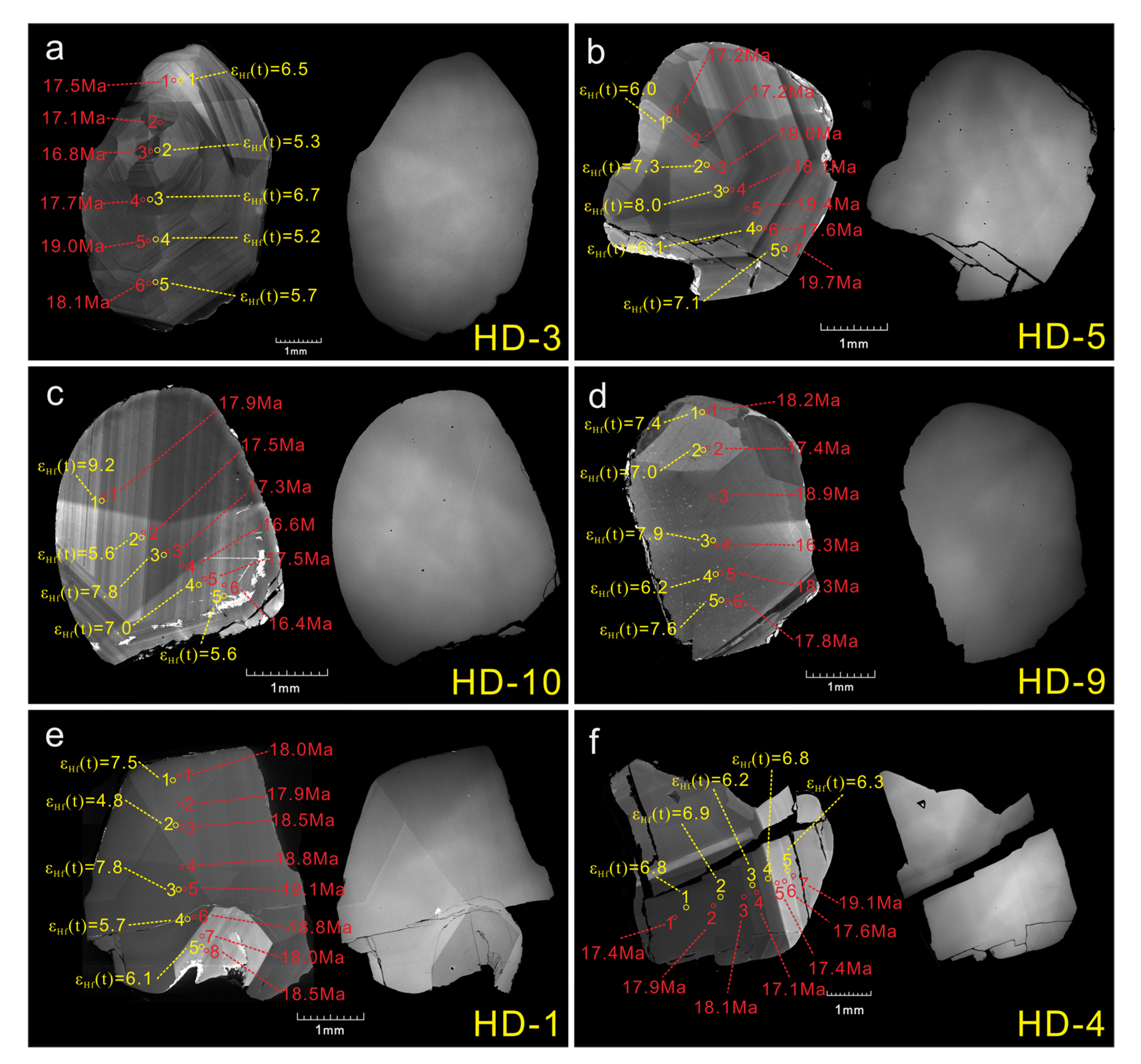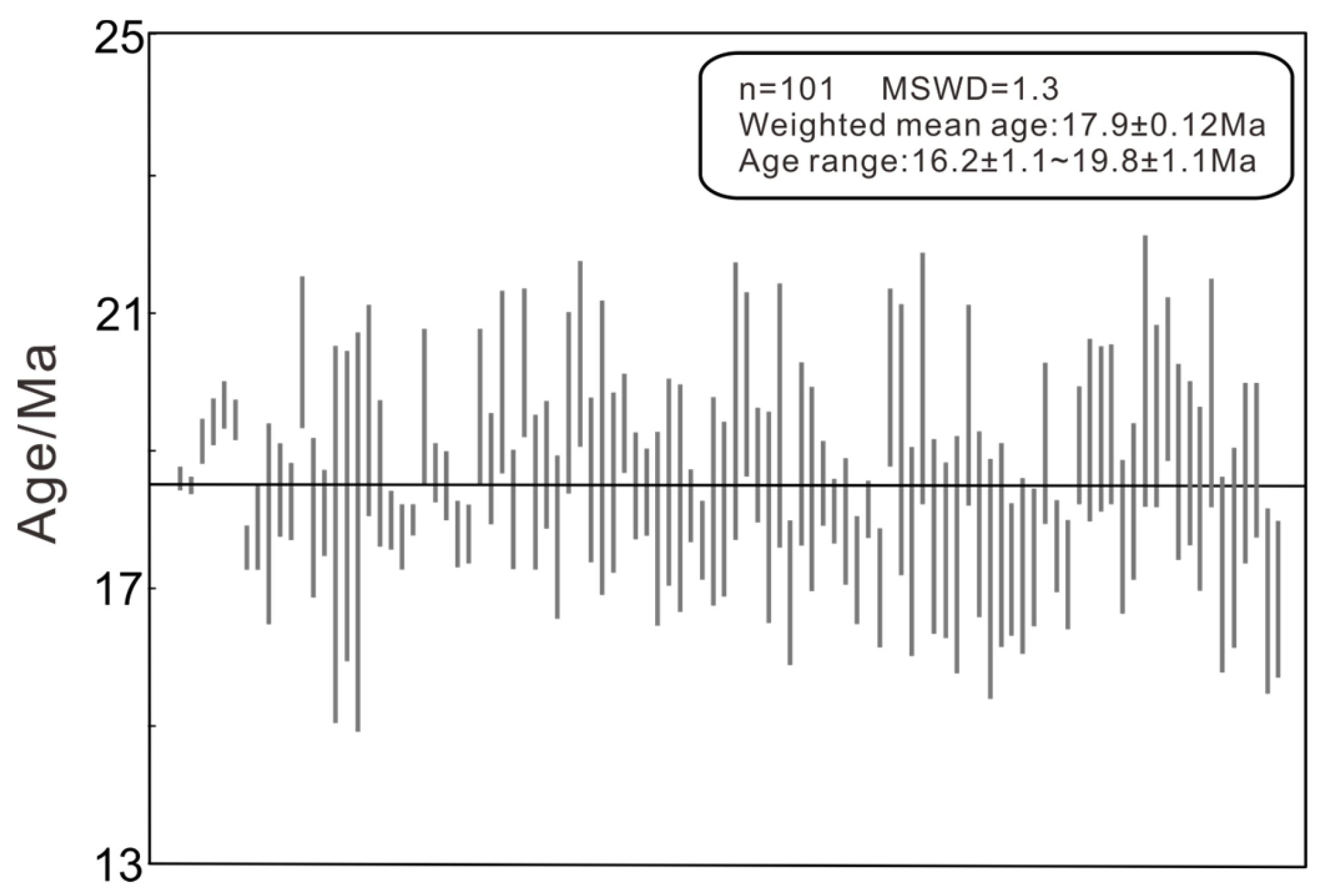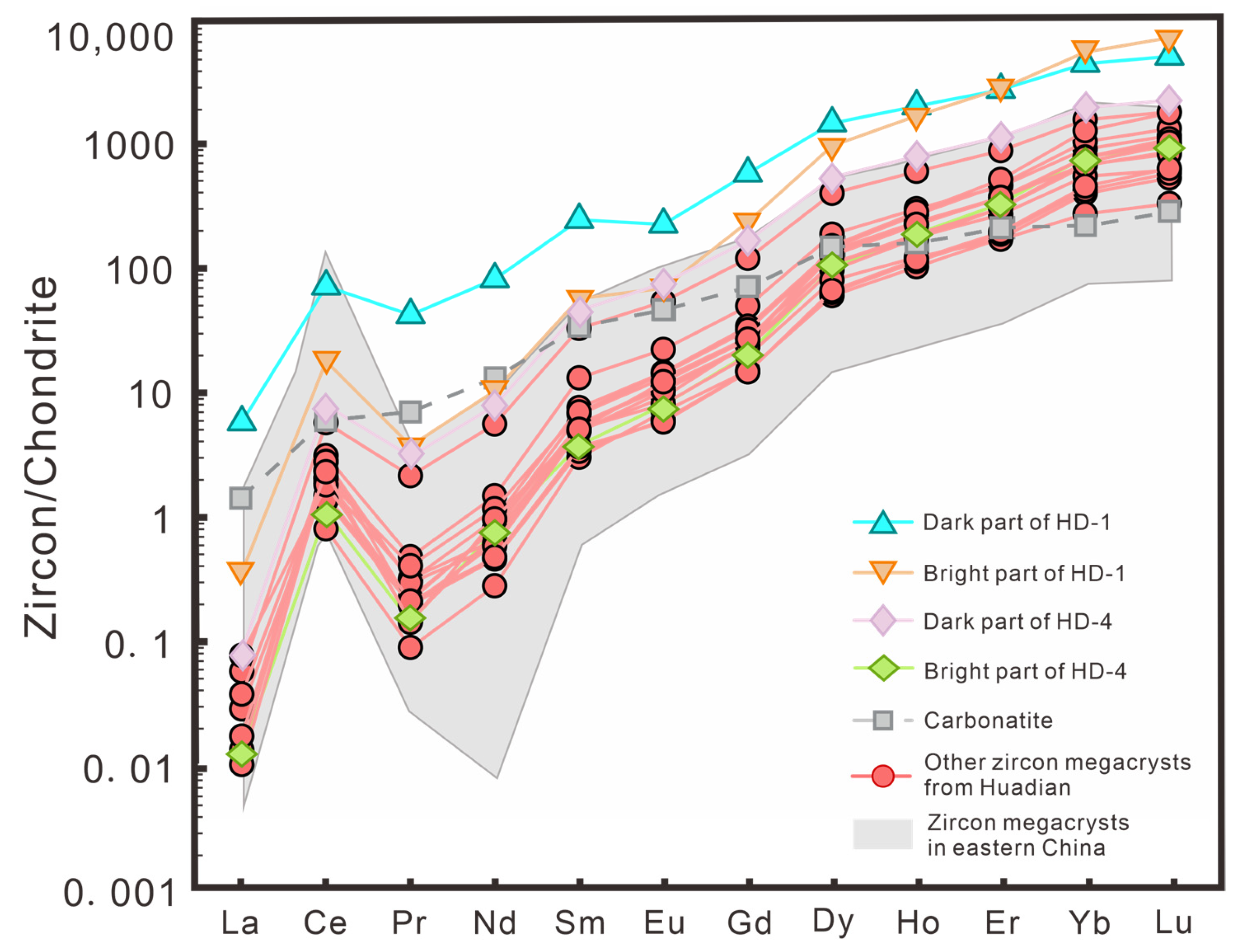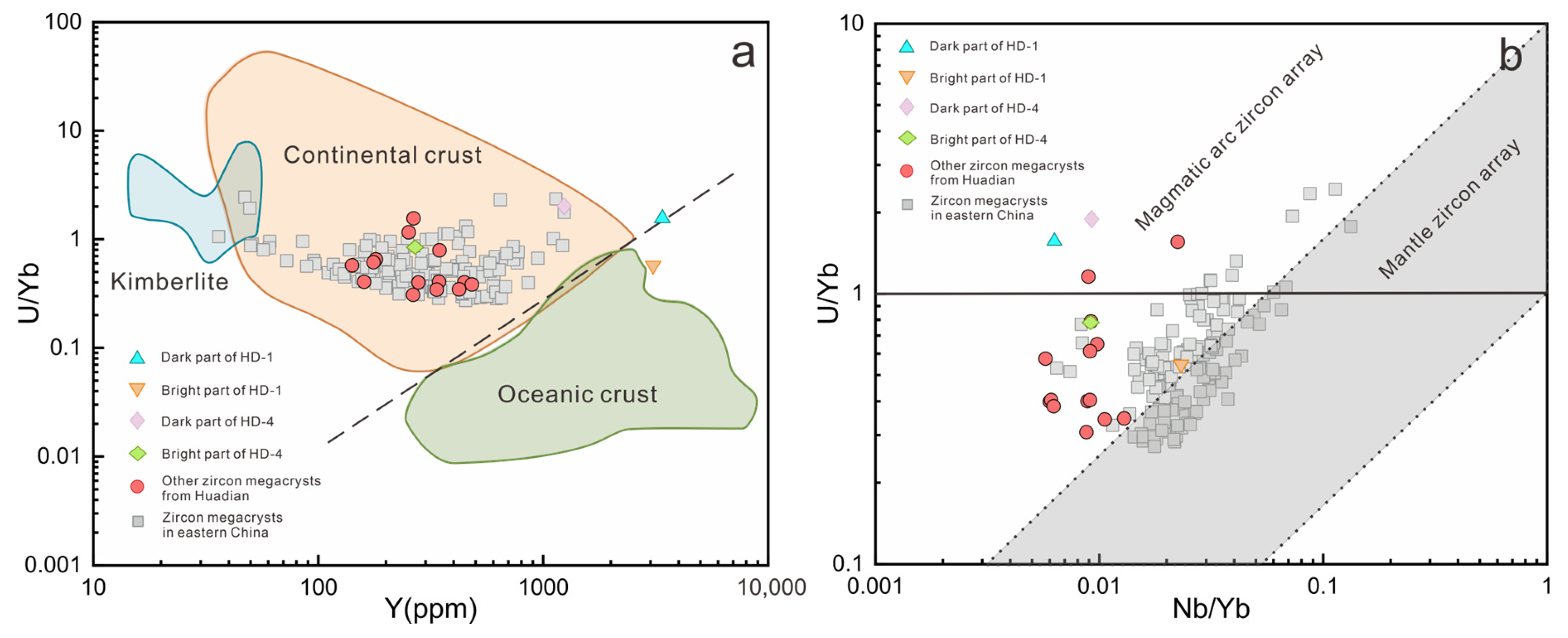Age and Geochemistry of Zircon Megacrysts from Alluvial Deposits in the Huadian Area, Northeastern China
Abstract
:1. Introduction
2. Geological Background and Sample Description
Geological Background
3. Methods
4. Results
4.1. Zircon Morphology and Internal Structure
4.2. U-Pb Geochronology and Hf Isotopic Compositions
4.3. Τrace Element Compositions
5. Discussion
5.1. Source Affinities of Zircon Megacrysts
5.2. Age Relationship between Zircon Megacrysts and Host Basalts
5.3. Provenance of Zircon Megacrysts
6. Conclusions
Supplementary Materials
Author Contributions
Funding
Data Availability Statement
Acknowledgments
Conflicts of Interest
References
- Corfu, F.; Hanchar, J.M.; Hoskin, P.W.O.; Kinny, P. Atlas of Zircon Textures. Rev. Mineral. Geochem. 2003, 53, 469–500. [Google Scholar] [CrossRef]
- Valley, J.W.; Cavosie, A.J.; Ushikubo, T.; Reinhard, D.A.; Lawrence, D.F.; Larson, D.J.; Clifton, P.H.; Kelly, T.F.; Wilde, S.A.; Moser, D.E.; et al. Hadean Age for a Post-Magma-Ocean Zircon Confirmed by Atom-Probe Tomography. Nat. Geosci. 2014, 7, 219–223. [Google Scholar] [CrossRef]
- Belousova, E.; Griffin, W.; O’Reilly, S.Y.; Fisher, N. Igneous Zircon: Trace Element Composition as an Indicator of Source Rock Type. Contrib. Miner. Pet. 2002, 143, 602–622. [Google Scholar] [CrossRef]
- Hoskin, P.W.O.; Schaltegger, U. The Composition of Zircon and Igneous and Metamorphic Petrogenesis. Rev. Mineral. Geochem. 2003, 53, 27–62. [Google Scholar] [CrossRef]
- Page, F.Z.; Fu, B.; Kita, N.T.; Fournelle, J.; Spicuzza, M.J.; Schulze, D.J.; Viljoen, F.; Basei, M.A.S.; Valley, J.W. Zircons from Kimberlite: New Insights from Oxygen Isotopes, Trace Elements, and Ti in Zircon Thermometry. Geochim. Cosmochim. Acta 2007, 71, 3887–3903. [Google Scholar] [CrossRef]
- Graham, I.; Sutherland, L.; Zaw, K.; Nechaev, V.; Khanchuk, A. Advances in Our Understanding of the Gem Corundum Deposits of the West Pacific Continental Margins Intraplate Basaltic Fields. Ore Geol. Rev. 2008, 34, 200–215. [Google Scholar] [CrossRef]
- Sutherland, F.L.; Duroc-Danner, J.M.; Meffre, S. Age and Origin of Gem Corundum and Zircon Megacrysts from the Mercaderes–Rio Mayo Area, South-West Colombia, South America. Ore Geol. Rev. 2008, 34, 155–168. [Google Scholar] [CrossRef]
- Sutherland, L.; Graham, I.; Yaxley, G.; Armstrong, R.; Giuliani, G.; Hoskin, P.; Nechaev, V.; Woodhead, J. Major Zircon Megacryst Suites of the Indo-Pacific Lithospheric Margin (ZIP) and Their Petrogenetic and Regional Implications. Min. Pet. 2016, 110, 399–420. [Google Scholar] [CrossRef]
- Abduriyim, A.; Sutherland, F.L.; Belousova, E.A. U–Pb Age and Origin of Gem Zircon from the New England Sapphire Fields, New South Wales, Australia. Aust. J. Earth Sci. 2012, 59, 1067–1081. [Google Scholar] [CrossRef]
- Sinh, V.B.T.; Osanai, Y.; Lenz, C.; Nakano, N.; Adachi, T.; Belousova, E.; Kitano, I. Gem-Quality Zircon Megacrysts from Placer Deposits in the Central Highlands, Vietnam—Potential Source and Links to Cenozoic Alkali Basalts. Minerals 2019, 9, 89. [Google Scholar] [CrossRef] [Green Version]
- Yu, X.; Zeng, G.; Chen, L.-H.; Hu, S.-L.; Yu, Z.-Q. Magma–Magma Interaction in the Mantle Recorded by Megacrysts from Cenozoic Basalts in Eastern China. Int. Geol. Rev. 2019, 61, 675–691. [Google Scholar] [CrossRef]
- Sun, P.; Niu, Y.; Guo, P.; Duan, M.; Wang, X.; Gong, H.; Xiao, Y. The Lithospheric Thickness Control on the Compositional Variation of Continental Intraplate Basalts: A Demonstration Using the Cenozoic Basalts and Clinopyroxene Megacrysts from Eastern China. J. Geophys. Res. Solid Earth 2020, 125. [Google Scholar] [CrossRef]
- Hu, L.; Pan, S.; Lu, R.; Zheng, J.; Dai, H.; Guo, A.; Yu, L.; Sun, H. Origin of Gem-Quality Megacrysts in the Cenozoic Alkali Basalts from the Muling Area, Northeastern China. Lithos 2022, 422–423, 106720. [Google Scholar] [CrossRef]
- Piilonen, P.; Sutherland, F.; Danišík, M.; Poirier, G.; Valley, J.; Rowe, R. Zircon Xenocrysts from Cenozoic Alkaline Basalts of the Ratanakiri Volcanic Province (Cambodia), Southeast Asia—Trace Element Geochemistry, O-Hf Isotopic Composition, U-Pb and (U-Th)/He Geochronology—Revelations into the Underlying Lithospheric Mantle. Minerals 2018, 8, 556. [Google Scholar] [CrossRef] [Green Version]
- Upton, B.G.J.; Hinton, R.W.; Aspen, P.; Finch, A.; Valley, J.W. Megacrysts and Associated Xenoliths: Evidence for Migration of Geochemically Enriched Melts in the Upper Mantle beneath Scotland. J. Petrol. 1999, 40, 935–956. [Google Scholar] [CrossRef]
- Visonà, D.; Caironi, V.; Carraro, A.; Dallai, L.; Fioretti, A.M.; Fanning, M. Zircon Megacrysts from Basalts of the Venetian Volcanic Province (NE Italy): U–Pb Ages, Oxygen Isotopes and REE Data. Lithos 2007, 94, 168–180. [Google Scholar] [CrossRef]
- Li, X.H.; Long, W.G.; Guo, C.H.; Liu, Y. Penglai Zircon: A Potential New Reference for Microbeam Analysis of U-Pb Age and O-Hf Isotopes. Geochim. et Cosmochim. Acta 2008, 72, A547, (In Chinese with English Abstract). [Google Scholar]
- Siebel, W.; Schmitt, A.K.; Danišík, M.; Chen, F.; Meier, S.; Weiß, S.; Eroǧlu, S. Prolonged Mantle Residence of Zircon Xenocrysts from the Western Eger Rift. Nat. Geosci. 2009, 2, 886–890. [Google Scholar] [CrossRef]
- Simonetti, A.; Neal, C.R. In-Situ Chemical, U–Pb Dating, and Hf Isotope Investigation of Megacrystic Zircons, Malaita (Solomon Islands): Evidence for Multi-Stage Alkaline Magmatic Activity beneath the Ontong Java Plateau. Earth Planet. Sci. Lett. 2010, 295, 251–261. [Google Scholar] [CrossRef]
- Schmitt, A.K.; Klitzke, M.; Gerdes, A.; Schäfer, C. Zircon Hafnium—Oxygen Isotope and Trace Element Petrochronology of Intraplate Volcanic Rocks from the Eifel (Germany) and Implications for Mantle versus Crustal Origins of Zircon Megacrysts. J. Petrol. 2017, 58, 1841–1870. [Google Scholar] [CrossRef] [Green Version]
- Liu, R.X. Chronology and Geochemistry of Cenozoic Volcanic Rocks in China; Seismological Press: Beijing, China, 1992; ISBN 7-5028-0624-5. [Google Scholar]
- Qiu, Z.; Wu, F.; Yu, Q.; Xie, L.; Yang, S. Hf Isotopes of Zircon Megacrysts from the Cenozoic Basalts in Eastern China. Chin. Sci. Bull. 2005, 50, 2602. [Google Scholar] [CrossRef]
- Yu, Y.; Xu, X.; Chen, X. Genesis of Zircon Megacrysts in Cenozoic Alkali Basalts and the Heterogeneity of Subcontinental Lithospheric Mantle, Eastern China. Min. Pet. 2010, 100, 75–94. [Google Scholar] [CrossRef]
- Jin, D.G. Jilin City, Jilin Province, K-52-1 Regional Geological Survey Report, 1:200,000; Jilin Provincial Bureau of Geology: Jilin, China, 1970. [Google Scholar]
- Jahn, B.M.; Wu, F.; Chen, B. Granitoids of the Central Asian Orogenic Belt and Continental Growth in the Phanerozoic. Spec. Pap. Geol. Soc. Am. 2000, 350, 181–193. [Google Scholar] [CrossRef]
- Windley, B.F.; Alexeiev, D.; Xiao, W.; Kröner, A.; Badarch, G. Tectonic Models for Accretion of the Central Asian Orogenic Belt. JGS 2007, 164, 31–47. [Google Scholar] [CrossRef] [Green Version]
- Şengör, A.M.C.; Natal’in, B.A.; Burtman, V.S. Evolution of the Altaid Tectonic Collage and Palaeozoic Crustal Growth in Eurasia. Nature 1993, 364, 299–307. [Google Scholar] [CrossRef]
- Xiao, W.; Windley, B.F.; Hao, J.; Zhai, M. Accretion Leading to Collision and the Permian Solonker Suture, Inner Mongolia, China: Termination of the Central Asian Orogenic Belt: Solonker Suturing in Inner Mongolia. Tectonics 2003, 22, 1–20. [Google Scholar] [CrossRef] [Green Version]
- Zhou, J.-B.; Wilde, S.A.; Zhang, X.-Z.; Ren, S.-M.; Zheng, C.-Q. Early Paleozoic Metamorphic Rocks of the Erguna Block in the Great Xing’an Range, NE China: Evidence for the Timing of Magmatic and Metamorphic Events and Their Tectonic Implications. Tectonophysics 2011, 499, 105–117. [Google Scholar] [CrossRef]
- Zhou, J.-B.; Li, L. The Mesozoic Accretionary Complex in Northeast China: Evidence for the Accretion History of Paleo-Pacific Subduction. J. Asian Earth Sci. 2017, 145, 91–100. [Google Scholar] [CrossRef]
- Li, Y.; Xu, W.-L.; Zhu, R.-X.; Wang, F.; Ge, W.-C.; Sorokin, A.A. Late Jurassic to Early Early Cretaceous Tectonic Nature on the NE Asian Continental Margin: Constraints from Mesozoic Accretionary Complexes. Earth-Sci. Rev. 2020, 200, 103042. [Google Scholar] [CrossRef]
- Şengör, A.M.C.; Lom, N.; Polat, A. The Nature and Origin of Cratons Constrained by Their Surface Geology. GSA Bull. 2022, 134, 1485–1505. [Google Scholar] [CrossRef]
- Wu, F.-Y.; Zhao, G.-C.; Sun, D.-Y.; Wilde, S.A.; Yang, J.-H. The Hulan Group: Its Role in the Evolution of the Central Asian Orogenic Belt of NE China. J. Asian Earth Sci. 2007, 30, 542–556. [Google Scholar] [CrossRef]
- Wang, C.; Jianchao, L.; Haidong, Z.; Jiakun, G.; Zhixuan, X.; Haoran, W. Mineralogical Features and Petrogenetic Significance of the Clinopyroxene and Hornblende of the Wuhaolai Mafic Complex in Northern North China Craton, Inner Mongolia. Earth Sci. Res. J. 2019, 23, 133–146. [Google Scholar] [CrossRef] [Green Version]
- Tang, Y.J.; Zhang, H.F.; Ying, J.F. Genetic Significance of Triassic Alkali-Rich Intrusive Rocks in the Yinshan and Neighboring Areas. Acta Petrol. Sin. 2014, 30, 2031–2040, (In Chinese with English Abstract). [Google Scholar]
- Zhang, M.; Suddaby, P.; O’Reilly, S.Y.; Norman, M.; Qiu, J. Nature of the Lithospheric Mantle beneath the Eastern Part of the Central Asian Fold Belt: Mantle Xenolith Evidence. Tectonophysics 2000, 328, 131–156. [Google Scholar] [CrossRef]
- Pan, S.; Zheng, J.; Griffin, W.L.; Xu, Y.; Li, X. Nature and Evolution of the Lithospheric Mantle beneath the Eastern Central Asian Orogenic Belt: Constraints from Peridotite Xenoliths in the Central Part of the Great Xing’an Range, NE China. Lithos 2015, 238, 52–63. [Google Scholar] [CrossRef]
- Sun, X.M.; Zhang, X.Q.; He, S.; Wang, P.J.; Zheng, H. Two Important Cretaceous Deformation Events of the Dunhua-Mishan Fault Zone. Acta Petrol. Sin. 2016, 32, 1114–1128, (In Chinese with English Abstract). [Google Scholar]
- Zhu, G.; Liu, C.; Gu, C.; Zhang, S.; Li, Y.J. Oceanic Plate Subduction History in the Western Pacific Ocean: Constraint from Late Mesozoic Evolution of the Tan-Lu Fault Zone. Sci. China Earth Sci. 2018, 61, 386–405. [Google Scholar] [CrossRef]
- JIN, K.; Guan, H.; Yu, M.; Yin, S.; GUO, Z.; Jia, H.; Chu, X.; Ren, J.; Wang, X. Prospecting Direction for Ruby and Sapphire from Cenozoic Basalt in Jilin Province. Glob. Geol. 2014, 33, 609–614. [Google Scholar] [CrossRef]
- Zong, K.; Klemd, R.; Yuan, Y.; He, Z.; Guo, J.; Shi, X.; Liu, Y.; Hu, Z.; Zhang, Z. The Assembly of Rodinia: The Correlation of Early Neoproterozoic (ca. 900 Ma) High-Grade Metamorphism and Continental Arc Formation in the Southern Beishan Orogen, Southern Central Asian Orogenic Belt (CAOB). Precambrian Res. 2017, 290, 32–48. [Google Scholar] [CrossRef]
- Liu, Y.; Hu, Z.; Gao, S.; Günther, D.; Xu, J.; Gao, C.; Chen, H. In Situ Analysis of Major and Trace Elements of Anhydrous Minerals by LA-ICP-MS without Applying an Internal Standard. Chem. Geol. 2008, 257, 34–43. [Google Scholar] [CrossRef]
- Liu, Y.; Gao, S.; Hu, Z.; Gao, C.; Zong, K.; Wang, D. Continental and Oceanic Crust Recycling-Induced Melt-Peridotite Interactions in the Trans-North China Orogen: U-Pb Dating, Hf Isotopes and Trace Elements in Zircons from Mantle Xenoliths. J. Petrol. 2010, 51, 537–571. [Google Scholar] [CrossRef]
- Ludwig, K.R. User’s Manual for Isoplot/Ex Rev. 3.00: A Geochronological Toolkit for Microsoft Excel. Berkeley Geochronol. Cent. Spec. Publ. 2003, 4, 74. [Google Scholar]
- Hu, Z.; Zhang, W.; Liu, Y.; Gao, S.; Li, M.; Zong, K.; Chen, H.; Hu, S. “Wave” Signal-Smoothing and Mercury-Removing Device for Laser Ablation Quadrupole and Multiple Collector ICPMS Analysis: Application to Lead Isotope Analysis. Anal. Chem. 2015, 87, 1152–1157. [Google Scholar] [CrossRef] [PubMed]
- Hu, Z.; Liu, Y.; Gao, S.; Liu, W.; Zhang, W.; Tong, X.; Lin, L.; Zong, K.; Li, M.; Chen, H.; et al. Improved in Situ Hf Isotope Ratio Analysis of Zircon Using Newly Designed X Skimmer Cone and Jet Sample Cone in Combination with the Addition of Nitrogen by Laser Ablation Multiple Collector ICP-MS. J. Anal. At. Spectrom. 2012, 27, 1391–1399. [Google Scholar] [CrossRef]
- Qiu, Z. Geochemistry and Hf Isotopes of Zircon Megacrysts in Cenozoic Basalts Along Eastern China and Its Implications for Crust-Mantle Interaction Beneath Subcontinental Lithosphere Mantle; Zhejiang University: Hangzhou, China, 2009. [Google Scholar]
- Sun, S.-S.; McDonough, W.F. Chemical and Isotopic Systematics of Oceanic Basalts: Implications for Mantle Composition and Processes. Geol. Soc. 1989, 42, 313–345. [Google Scholar] [CrossRef]
- Harley, S.L.; Kelly, N.M. Zircon Tiny but Timely. Elements 2007, 3, 13–18. [Google Scholar] [CrossRef]
- Corfu, F.; Polteau, S.; Planke, S.; Faleide, J.I.; Svensen, H.; Zayoncheck, A.; Stolbov, N. U–Pb Geochronology of Cretaceous Magmatism on Svalbard and Franz Josef Land, Barents Sea Large Igneous Province. Geol. Mag. 2013, 150, 1127–1135. [Google Scholar] [CrossRef]
- Zhu, Z.; Campbell, I.H.; Allen, C.M.; Brocks, J.J.; Chen, B. The Temporal Distribution of Earth’s Supermountains and Their Potential Link to the Rise of Atmospheric Oxygen and Biological Evolution. Earth Planet. Sci. Lett. 2022, 580, 117391. [Google Scholar] [CrossRef]
- Borghini, G.; Fumagalli, P.; Rampone, E. The Stability of Plagioclase in the Upper Mantle: Subsolidus Experiments on Fertile and Depleted Lherzolite. J. Petrol. 2010, 51, 229–254. [Google Scholar] [CrossRef] [Green Version]
- Griffin, W.L.; Pearson, N.J.; Belousova, E.; Jackson, S.E.; van Achterbergh, E.; O’Reilly, S.Y.; Shee, S.R. The Hf Isotope Composition of Cratonic Mantle: LAM-MC-ICPMS Analysis of Zircon Megacrysts in Kimberlites. Geochim. Cosmochim. Acta 2000, 64, 133–147. [Google Scholar] [CrossRef]
- Heaman, L.M.; Creaser, R.A.; Cookenboo, H.O.; Chacko, T. Multi-Stage Modification of the Northern Slave Mantle Lithosphere: Evidence from Zircon- and Diamond-Bearing Eclogite Xenoliths Entrained in Jericho Kimberlite, Canada. J. Petrol. 2006, 47, 821–858. [Google Scholar] [CrossRef]
- Giuliani, A.; Phillips, D.; Woodhead, J.D.; Kamenetsky, V.S.; Fiorentini, M.L.; Maas, R.; Soltys, A.; Armstrong, R.A. Did Diamond-Bearing Orangeites Originate from MARID-Veined Peridotites in the Lithospheric Mantle? Nat. Commun. 2015, 6, 6837. [Google Scholar] [CrossRef] [Green Version]
- Sun, J.; Tappe, S.; Kostrovitsky, S.I.; Liu, C.-Z.; Skuzovatov, S.Y.; Wu, F.-Y. Mantle Sources of Kimberlites through Time: A U-Pb and Lu-Hf Isotope Study of Zircon Megacrysts from the Siberian Diamond Fields. Chem. Geol. 2018, 479, 228–240. [Google Scholar] [CrossRef]
- Boehnke, P.; Watson, E.B.; Trail, D.; Harrison, T.M.; Schmitt, A.K. Zircon Saturation Re-Revisited. Chem. Geol. 2013, 351, 324–334. [Google Scholar] [CrossRef]
- Borisova, A.Y.; Bindeman, I.N.; Toplis, M.J.; Zagrtdenov, N.R.; Guignard, J.; Safonov, O.G.; Bychkov, A.Y.; Shcheka, S.; Melnik, O.E.; Marchelli, M.; et al. Zircon Survival in Shallow Asthenosphere and Deep Lithosphere. Am. Mineral. 2020, 105, 1662–1671. [Google Scholar] [CrossRef]
- Garnier, V.; Ohnenstetter, D.; Giuliani, G.; Fallick, A.E.; Phan Trong, T.; Hoàng Quang, V.; Pham Van, L.; Schwarz, D. Basalt Petrology, Zircon Ages and Sapphire Genesis from Dak Nong, Southern Vietnam. Mineral. Mag. 2005, 69, 21–38. [Google Scholar] [CrossRef]
- Hoskin, P.W.O.; Ireland, T.R. Rare Earth Element Chemistry of Zircon and Its Use as a Provenance Indicator. Geology 2000, 28, 627. [Google Scholar] [CrossRef]
- Grimes, C.B.; John, B.E.; Kelemen, P.B.; Mazdab, F.K.; Wooden, J.L.; Cheadle, M.J.; Hanghøj, K.; Schwartz, J.J. Trace Element Chemistry of Zircons from Oceanic Crust: A Method for Distinguishing Detrital Zircon Provenance. Geology 2007, 35, 643. [Google Scholar] [CrossRef]
- Campbell, L.S.; Compston, W.; Sircombe, K.N.; Wilkinson, C.C. Zircon from the East Orebody of the Bayan Obo Fe–Nb–REE Deposit, China, and SHRIMP Ages for Carbonatite-Related Magmatism and REE Mineralization Events. Contrib. Miner. Pet. 2014, 168, 1041. [Google Scholar] [CrossRef] [Green Version]
- Saava, E.V.; Belyastsky, B.V.; Antonov, A.B. Carbonatitic Zircon-Myth or Reality: Mineralogical-Geochemical Analyses. Available online: http://alkaline09.narod.ru/abstracts/Savva_Belyatsky.Htm (accessed on 30 December 2018).
- Foley, S.F.; Yaxley, G.M.; Rosenthal, A.; Buhre, S.; Kiseeva, E.S.; Rapp, R.P.; Jacob, D.E. The Composition of Near-Solidus Melts of Peridotite in the Presence of CO2 and H2O between 40 and 60 Kbar. Lithos 2009, 112, 274–283. [Google Scholar] [CrossRef]
- Grimes, C.B.; Wooden, J.L.; Cheadle, M.J.; John, B.E. “Fingerprinting” Tectono-Magmatic Provenance Using Trace Elements in Igneous Zircon. Contrib. Mineral. Petrol. 2015, 170, 46. [Google Scholar] [CrossRef]
- Turner, S.; Wilde, S.; Wörner, G.; Schaefer, B.; Lai, Y.-J. An Andesitic Source for Jack Hills Zircon Supports Onset of Plate Tectonics in the Hadean. Nat. Commun. 2020, 11, 1241. [Google Scholar] [CrossRef] [PubMed] [Green Version]
- Xu, X.; O’Reilly, S.Y.; Griffin, W.L.; Zhou, X. Enrichment of Upper Mantle Peridotite: Petrological, Trace Element and Isotopic Evidence in Xenoliths from SE China. Chem. Geol. 2003, 198, 163–188. [Google Scholar] [CrossRef]
- Xu, X.; O’Reilly, S.Y.; Griffin, W.L.; Zhou, X. Genesis of Young Lithospheric Mantle in Southeastern China: An LAM–ICPMS Trace Element Study. J. Petrol. 2000, 41, 111–148. [Google Scholar] [CrossRef]
- Zhang, H.-F. Transformation of Lithospheric Mantle through Peridotite-Melt Reaction: A Case of Sino-Korean Craton. Earth Planet. Sci. Lett. 2005, 237, 768–780. [Google Scholar] [CrossRef]
- Zheng, J.P.; Griffin, W.L.; O’Reilly, S.Y.; Yu, C.M.; Zhang, H.F.; Pearson, N.; Zhang, M. Mechanism and Timing of Lithospheric Modification and Replacement beneath the Eastern North China Craton: Peridotitic Xenoliths from the 100 Ma Fuxin Basalts and a Regional Synthesis. Geochim. Cosmochim. Acta 2007, 71, 5203–5225. [Google Scholar] [CrossRef]
- Xu, W.; Hergt, J.M.; Gao, S.; Pei, F.; Wang, W.; Yang, D. Interaction of Adakitic Melt-Peridotite: Implications for the High-Mg # Signature of Mesozoic Adakitic Rocks in the Eastern North China Craton. Earth Planet. Sci. Lett. 2008, 265, 123–137. [Google Scholar] [CrossRef]
- Tang, Y.-J.; Zhang, H.-F.; Ying, J.-F.; Su, B.-X. Widespread Refertilization of Cratonic and Circum-Cratonic Lithospheric Mantle. Earth-Sci. Rev. 2013, 118, 45–68. [Google Scholar] [CrossRef]
- Lin, A.-B.; Zheng, J.-P.; Xiong, Q.; Aulbach, S.; Lu, J.-G.; Pan, S.-K.; Dai, H.-K.; Zhang, H. A Refined Model for Lithosphere Evolution beneath the Decratonized Northeastern North China Craton. Contrib. Miner. Pet. 2019, 174, 15. [Google Scholar] [CrossRef]
- Zhou, Q.; Wu, F.Y.; Yang, Y.H.; Sun, D.Y.; Ge, W.C. Sr-Nd-Hf-Os Isotopic Characterizations of the Jiaohe Peridotite Xenoliths in Jilin Province and Constraints on the Lithospheric Mantle Age in Northeastern China. Acta Petrol. Sin. 2007, 23, 1269–1280, (In Chinese with English Abstract). [Google Scholar]
- Yu, S.-Y.; Xu, Y.-G.; Huang, X.-L.; Ma, J.-L.; Ge, W.-C.; Zhang, H.-H.; Qin, X.-F. Hf–Nd Isotopic Decoupling in Continental Mantle Lithosphere beneath Northeast China: Effects of Pervasive Mantle Metasomatism. J. Asian Earth Sci. 2009, 35, 554–570. [Google Scholar] [CrossRef]
- Niu, Y. Generation and Evolution of Basaltic Magmas: Some Basic Concepts and a Hypothesis for the Origin of the Mesozoic-Cenozoic Volcanism in Eastern China. Geol. J. China Univ. 2005, 11, 9–46. [Google Scholar]
- Huang, J.; Zhao, D. High-Resolution Mantle Tomography of China and Surrounding Regions. J. Geophys. Res. 2006, 111, B09305. [Google Scholar] [CrossRef]
- Xu, Y.; Li, H.; Hong, L.; Ma, L.; Ma, Q.; Sun, M. Generation of Cenozoic Intraplate Basalts in the Big Mantle Wedge under Eastern Asia. Sci. China Earth Sci. 2018, 61, 869–886. [Google Scholar] [CrossRef]
- Lin, J.; Xu, Y.; Sun, Z.; Zhou, Z. Mantle Upwelling beneath the South China Sea and Links to Surrounding Subduction Systems. Natl. Sci. Rev. 2019, 6, 877–881. [Google Scholar] [CrossRef] [PubMed] [Green Version]








Disclaimer/Publisher’s Note: The statements, opinions and data contained in all publications are solely those of the individual author(s) and contributor(s) and not of MDPI and/or the editor(s). MDPI and/or the editor(s) disclaim responsibility for any injury to people or property resulting from any ideas, methods, instructions or products referred to in the content. |
© 2023 by the authors. Licensee MDPI, Basel, Switzerland. This article is an open access article distributed under the terms and conditions of the Creative Commons Attribution (CC BY) license (https://creativecommons.org/licenses/by/4.0/).
Share and Cite
Sun, H.; Pan, S.; Qin, H.; Liu, Y.; Wu, X. Age and Geochemistry of Zircon Megacrysts from Alluvial Deposits in the Huadian Area, Northeastern China. Minerals 2023, 13, 882. https://doi.org/10.3390/min13070882
Sun H, Pan S, Qin H, Liu Y, Wu X. Age and Geochemistry of Zircon Megacrysts from Alluvial Deposits in the Huadian Area, Northeastern China. Minerals. 2023; 13(7):882. https://doi.org/10.3390/min13070882
Chicago/Turabian StyleSun, Haiqi, Shaokui Pan, Hongyu Qin, Yimiao Liu, and Xiaolong Wu. 2023. "Age and Geochemistry of Zircon Megacrysts from Alluvial Deposits in the Huadian Area, Northeastern China" Minerals 13, no. 7: 882. https://doi.org/10.3390/min13070882
APA StyleSun, H., Pan, S., Qin, H., Liu, Y., & Wu, X. (2023). Age and Geochemistry of Zircon Megacrysts from Alluvial Deposits in the Huadian Area, Northeastern China. Minerals, 13(7), 882. https://doi.org/10.3390/min13070882



